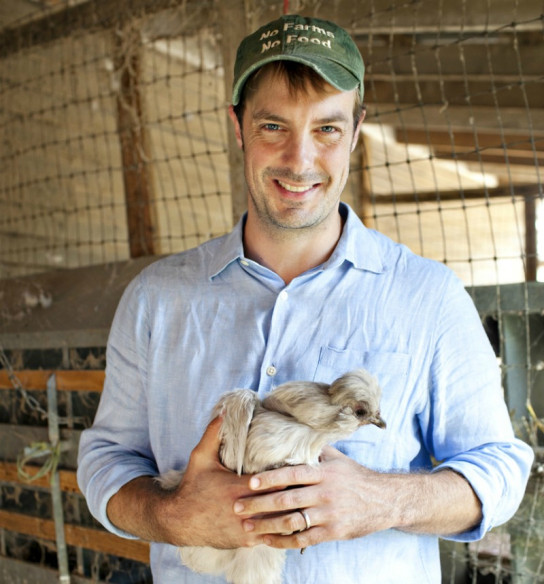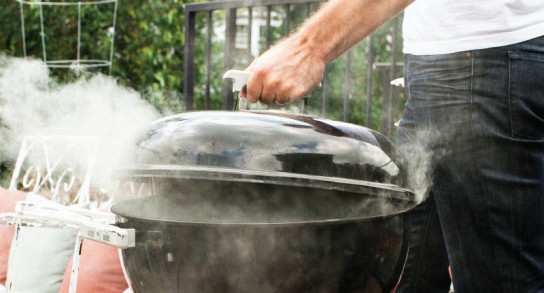This month we’ve partnered with Barton Seaver, a chef and cookbook author committed to studying and promoting sustainable food systems. He’s passionate about the connection between the environment, the food on our table, and our own health, exploring these themes with home cooks in his new grilling-focused book, Where There’s Smoke. Here, we ask Barton what he loves about grilling, how learning about sustainability changed his cooking, and how to pull off the perfect cookout at home.
Tell us about cooking throughout your childhood. What drew you to the grill?
Family dinner was the fundamental point of my childhood; we came together over family dinner every night of the week. My parents were intrepid and talented cooks, and they set the course for my career and my life. In my restaurants I have focused on replicating some of those flavors I experienced as a child and using the ideas of family dinner and gatherings, which really defined the values in my life. My father was well known for his culinary talents, but his ability on the grill was the most admired of all his skills. He knew instinctually how to coax every bit of flavor out of ingredients on a smoky fire. Warm summer evenings, gathered together around the grill — it’s a good way to spend your nights.
How would you describe your cooking style?
Ingredient-forward. Most of my recipes are aimed at highlighting and accentuating primary flavors, so it is more in the style of Italian than French. And I prefer to eat a number of dishes in a single meal rather than strictly composed plates: lots of salads and and grains and greens and some roasted or raw vegetables, and a small bit of protein. I like a collection of flavors throughout the meal rather than a curated palate on a single plate.
How did you become interested in cooking and eating sustainably, and what does that mean for you?
When I was a young chef, I became aware that much of the reward I was gaining from my hard work was in the relationships I was creating — not only with the guests who came through the front door but, equally important, with those who showed up at back door with the products I was to serve. I began to understand how a chef participates in the economies of food systems and how the choices chefs make have the power to sustain ideas and sustain communities.
Furthermore, I began to realize that so often in conversations about sustainability we forget to ask what it is we are trying to sustain. I believe we are trying to sustain ourselves, our ideas, our own communities and, most importantly, our health. Sustainability means to me balancing human needs with what the environment can provide so that every member of the community has equal opportunity to thrive. For too long, sustainability has been strictly a conversation about environmental impacts, and what I love about food is that it opens the door to discuss environmental impact through the lens of the human experience. It quite literally brings the world to our table.
What’s the most important thing people should know about sourcing their food?
That sustainability is often considered a conversation of what we use, how it was produced, where it was produced, etc., but equally important to any conversation of sustainability is not just what we use but how we use it. This opens up a huge opportunity for consumers, cooks, chefs, or anyone else to actively participate in sustainability by considering the foods we eat and using them in concert with our needs. By this I mean reduced but enjoyable portions of delicious, fresh, humane sustainable proteins, and lots of whole grains, greens and vegetables.
What I love about a meal is that there is no such thing as sustainable food unless we’re eating it sustainably. That specifically applies to sustainable protein; the meal isn’t sustainable if no vegetables are on the plate. If we acknowledge that we eat to sustain ourselves, then let’s truly acknowledge that and use food to its highest and best purpose, which is to eat healthfully. Eating healthfully and eating sustainably are pretty much the same thing.
Any grilling tips you swear by that people may not have heard before?
It’s all about air flow. You can’t control fire. Prometheus we are not. But we can control how much fuel the fire gets in terms of air flow and how far away or close to the fire our food is. It’s getting back to indirect heat. Play with heat and air flow, choking the fire and coaxing it to slow down and smolder, capturing the essence of fire and trying to wrangle it like a cowboy.
Gatherings around the grill beg for togetherness and conversation. It creates an opportunity; don’t bury your head in the fire. Cook things ahead. Tomato season is close by, so you can diversify the meal you’re serving with items that are easy to prep ahead of time. I like heirloom tomatoes with spicy olive oil or a raw zucchini salad tossed with ribbons of carrot and caramelized lemon with olive oil squeezed over it. You’re delivering a meal that is a total wow factor of texture and vibrant color, and you did most of the work before guests even arrived. By the time you’re grilling, you have a beer in hand and are sitting pretty with guests. The same is true with a family dinner for four.
People associate grilling with meat, but how do vegetables fit into your outdoor routine?
When we are outside cooking happens to be the same month that vegetables are at their peak and their diversity is most broad. That’s reason to celebrate right there. Why would you take the best of the season and relegate it to a side show? This is where I think not only do we hit on sustainability in terms of healthful, sustaining meals, we hit on sustainability because of diversity. You’re even saving a little money because vegetables cost less than meat. You’re providing more interest and appeal to the meal due to a diversity of textures, flavors and colors. Cool! Frankly, that’s what’s going to taste best. In the book, I very proudly feature veg; halfway through the book I haven’t even hit proteins yet. That speaks to how I hope people will actually use the book in helping to set up whole meals and to begin to think about how to put together a range of easy-to-prepare dishes that don’t require huge effort but deliver a huge reward.
Your book Where There’s Smoke focuses not just on grilling, but on outdoor entertaining. What’s your ideal outdoor gathering, and how can people pull it off at home?
The outdoor gathering is dependent on your place. That’s what I love so much about it: the meal becomes a part of the place you occupy. For me, it’s a well worn deck hanging over a rocky bluff with a beach down below and the tide pouring in; the salt air and breeze; plenty of light red wine and rose to go around, plus some cocktails; and a whole lot of vegetables prepared a head of time so that when guests arrive, everyone enjoys themselves. Including the person responsible for hosting it.
There’s something so primal about it. We all go to a barbecue, and people just can’t help themselves — they want to stand around the fire and poke at it. The grill master is the most coveted role. It’s a really fun way to highlight the joy of feeding others.
Do you cook at home? What’s your go-to meal to cook for family and friends?
I do, six nights a week. It’s great fun for a former chef to actually be able to cook what I want when I want it and to sit down and enjoy a meal with my wife. It’s the best part of my day. We eat a lot of shaved vegetable salads with anchovy vinaigrette, providing the protein almost as a garnish. I like shaved fennel on a mandolin with chopped olives — I throw in arugula and plucked parsley leaves, and a few segmented oranges, toss it together, and puree anchovies with sherry vinegar and olive oil. It’s a quick, satisfying meal. I also usually have big pots of a grain pilaf around, which I make every 2 or 3 days. I just sauté a sofrito in olive oil and add wild rice, barley or quinoa, toast it in oil, cover and steam it. For lunch and dinner, it’s super easy to pull out of the fridge, dress for a c0ld salad, and throw in pan to toast up. I toss it with mixed greens, which are ever present in our house.
Who or what inspires you in the kitchen? Any heroes?
My parents. They first taught me the value of food, not just the biology of it. There’s also the biography that we wrote together as a family around the dinner table. That’s what really motivates me: really helping people identify with each other, with the world, with their community through ingredients on a table. My parents taught me that.
What’s the best cooking advice you ever received? And the best you’ve ever given?
Slow down. Turn your heat down. Don’t kill the ingredients, they’re already dead. Also, taste, taste, taste. Taste the raw ingredients before you do anything to them. Taste the salt before you put it on. Taste the lemon before you squeeze it into the bowl. Taste the olive oil. Taste everything. You constantly see chefs dabbing their fingers into stuff; that’s our fluency. Good chefs are fluent in ingredients, constantly engaging with them. It’s something home cooks should attempt to do, too.
Take a recipe for lemon vinaigrette. What does lemon taste like? You have to answer that before I tell you what kind of olive oil to use, if it’s olive oil at all. That defines my cooking: ingredient focus. If you don’t know what the components taste like, how do you know what the final product will be? You can make adjustments along the way rather than being discouraged by the final result.
What’s your most prized kitchen possession?
I have a couple of those, and they all come from the same place. They are all hand-me-downs from grandmother’s kitchen. She’s no longer able to prepare meals for herself and was generous enough to pass down a KitchenAid and Robot-Coupe and pans and grapefruit spoons. Plus all of the antique kitchen utensils she collected — some I still use, and some are decorative. It’s really a rewarding thing to pick up something mindlessly, reach over for a spatula to get dinner rolling, and as you’re watching, to have your memory sparked of all those meals with your family and to know that physically and spiritually those practices live on. It’s really special to me.
Try recipes from Barton Seaver here.


